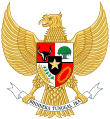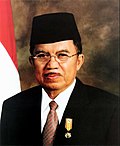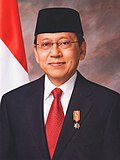List of vice presidents of Indonesia
Appearance
| This article is part of a series on the |
| Politics of Indonesia |
|---|
 |
This is a list of Vice-Presidents of Indonesia. The Vice-President of the Republic of Indonesia (Indonesian: Wakil Presiden Republik Indonesia) is the second most powerful person in the Republic of Indonesia and first in the line of succession.
The vice presidency was established during the formulation of the 1945 Constitution by the Investigating Committee for Preparatory Work for Independence (BPUPK), a research body for the preparation of Indonesian independence. On 18 August 1945, the Preparatory Committee for Indonesian Independence (PPKI), which was created on 7 August to replace the BPUPK, selected Sukarno as the country's first president and Mohammad Hatta as vice-president.[1]
Key
List of Vice-Presidents of Indonesia
| № | Portrait | Name (birth–death) |
Term of Office | Political Party | President(s) | ||
|---|---|---|---|---|---|---|---|
| 1 | 
|
Mohammad Hatta (1902–1980) |
18 August 1945[2] | 1 December 1956 [A] | Non-partisan | style="background:Template:Non-partisan/meta/color; color:white;"| | Sukarno |
| Post Vacant[B] (1 December 1956 – 22 March 1973) | |||||||
| style="background:Template:Non-partisan/meta/color; color:black;"|2 | 
|
Hamengkubuwono IX (1912–1988) |
22 March 1973[3] | 23 March 1978[C] | Non-partisan | style="background:Template:Golkar/meta/color; color:white;"| | Suharto |
| style="background:Template:Golkar/meta/color; color:black;"|3 | 
|
Adam Malik (1917–1984) |
23 March 1978 | 12 March 1983[4] | Golkar | style="background:Template:Golkar/meta/color; color:white;"| | Suharto |
| style="background:Template:Golkar/meta/color; color:black;"|4 | 
|
Umar Wirahadikusumah (1924–2003) |
12 March 1983 | 11 March 1988[4] | Golkar | style="background:Template:Golkar/meta/color; color:white;"| | Suharto |
| style="background:Template:Golkar/meta/color; color:black;"|5 | 
|
Sudharmono (1927–2006) |
11 March 1988 | 17 March 1993[5] | Golkar | style="background:Template:Golkar/meta/color; color:white;"| | Suharto |
| style="background:Template:Golkar/meta/color; color:black;"|6 | 
|
Try Sutrisno (1935– ) |
17 March 1993 | 14 March 1998 | Golkar | style="background:Template:Golkar/meta/color; color:white;"| | Suharto |
| style="background:Template:Golkar/meta/color; color:black;"|7 | 
|
B. J. Habibie (1936– ) |
14 March 1998 | 21 May 1998[D] | Golkar | style="background:Template:Golkar/meta/color; color:white;"| | Suharto |
| Vacant (21 May 1998 – 21 October 1999) | |||||||
| style="background:Template:Indonesian Democratic Party – Struggle/meta/color; color:white;"|8 | 
|
Megawati Sukarnoputri (1947– ) |
21 October 1999 | 23 July 2001[E] | Indonesian Democratic Party – Struggle | style="background:Template:National Awakening Party/meta/color; color:white;"| | Abdurrahman Wahid |
| style="background:Template:United Development Party/meta/color; color:white;"|9 | 
|
Hamzah Haz (1940– ) |
23 July 2001[6] | 20 October 2004 | United Development Party | style="background:Template:Indonesian Democratic Party – Struggle/meta/color; color:white;"| | Megawati Sukarnoputri |
| style="background:Template:Golkar/meta/color; color:black;"|10 | 
|
Jusuf Kalla (1942– ) |
20 October 2004[F] | 20 October 2009 | Golkar | style="background:Template:Democratic Party (Indonesia)/meta/color; color:white;"| | Susilo Bambang Yudhoyono |
| style="background:Template:Non-partisan/meta/color; color:black;"|11 | 
|
Boediono (1943– ) |
20 October 2009 | 20 October 2014 | Non-partisan | style="background:Template:Democratic Party (Indonesia)/meta/color; color:white;"| | Susilo Bambang Yudhoyono |
| style="background:Template:Golkar/meta/color; color:black;"|12 (10) |

|
Jusuf Kalla (1942– ) |
20 October 2014 | Incumbent | Golkar | style="background:Template:Indonesian Democratic Party – Struggle/meta/color; color:white;"| | Joko Widodo |
See also
Footnotes
- A Hatta announced his resignation from the Vice Presidency on 26 July 1956, effective 1 December 1956.[7] President Sukarno had moved the country increasingly toward autocracy and authoritarianism. Hatta, a proponent of democracy, advised President Sukarno not to take that path, but his recommendations were ignored. He decided to resign, as he believed he could not work with the president.
- B President Sukarno did not name Hatta's successor as Vice-President. In December 1965, there were calls for a Vice-President to be named to assist Sukarno with the fallout of the 30 September Movement and General Suharto's attempts to take over the government.[8] It was not until the New Order regime of President Suharto that the Vice-President post became filled again.
- C Vice-President Hamengkubuwono IX rejected his nomination for Vice-President by the People's Consultative Assembly in March 1978, due to poor health.[9] President Suharto believed that Hamengkubuwono IX had betrayed him by not seeking re-election.
- D Following the 1997 Asian Financial Crisis, there were calls for Suharto's resignation as President. In May 1998, he lost support from many of his allies, including Wiranto and Ginandjar Kartasasmita. On 21 May, Suharto formally announced his resignation from office. Habibie became his successor as the President of Indonesia.[10]
- E After Abdurrahman Wahid was impeached, Vice-President Megawati replaced him as President of Indonesia.[11]
- F Former security minister Susilo Bambang Yudhoyono chose Jusuf Kalla as his running mate in the July 2004 presidential election against the incumbent Megawati Sukarnoputri and her running mate Hasyim Muzadi. Yudhoyono led the candidates with 33.58% of the vote, but he had failed to capture the required majority. Thus, the election went into a second round runoff between Yudhoyono and Megawati. In the 24 September 2004 runoff, the Yudhoyono-Kalla ticket captured 60.62% of the vote, in comparison to Megawati-Muzadi's 39.38%. Yudhoyono and Kalla took office as President and Vice-President, respectively, on 20 October 2004.[12]
References
- Specific
- ^ Cribb & Kahin 2004, p. 312
- ^ Cribb & Kahin 2004, p. 171
- ^ Abdulgani-Knapp 2007, p. 91
- ^ a b Cribb & Kahin 2004, p. 479
- ^ Abdulgani-Knapp 2007, p. 162
- ^ Cribb & Kahin 2004, p. 269
- ^ Cribb & Kahin 2004, p. lii
- ^ Hughes 2002, p. 215
- ^ McIntyre 2005, p. 118
- ^ Vickers 2005, pp. 203–207
- ^ Cribb & Kahin 2004, p. lx
- ^ Suryadinata 2005, p. 142
- General
- Abdulgani-Knapp, Retnowati (2007), Soeharto: The Life and Legacy of Indonesia's Second President, Singapore: Marshall Cavendish, ISBN 981-261-340-4, OCLC 155758606.
- Cribb, Robert; Kahin, Audrey (2004), Historical Dictionary of Indonesia (2nd ed.), Lanham, Maryland: Scarecrow Press, ISBN 0-8108-4935-6, OCLC 53793487.
- Hughes, John (2002), The End of Sukarno: A Coup That Misfired: A Purge That Ran Wild (3rd ed.), Singapore: Archipelago Press, ISBN 981-4068-65-9, OCLC 52567484.
- McIntyre, Angus (2005), The Indonesian Presidency: The Shift from Personal Toward Constitutional Rule (3rd ed.), Lanham, Maryland: Rowman & Littlefield, ISBN 0-7425-3827-3, OCLC 59137499.
- Suryadinata, Leo (2005), "Indonesia: The Year of a Democratic Election", Southeast Asian Affairs, 2005, Singapore: Institute of Southeast Asian Studies: 133–149, doi:10.1355/SEAA-05H, ISSN 0377-5437.
- Vickers, Adrian (2005), A History of Modern Indonesia: An Enduring Rivalry, Cambridge: Cambridge University Press, ISBN 0-521-83493-7, OCLC 60794234.

